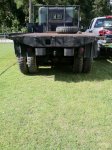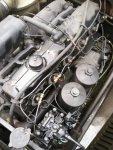Double clutching explained, See motto below.
When shifting a transmission up or down the mating gears need to be turning at the same rate. In modern day vehicles this is accomplished by syncros (synchronizes). The resistance you feel when shifting are the syncros doing its job. The heavier duty the transmission the bigger gear clusters then the more the syncros have to work, the more resistance when shifting. Back in the day i.e. 1920's and 1930's heavier trucks did not have syncros, you had to double clutch. Up-shifting is a breeze run up in 1st gear shift to neutral let clutch out push clutch then shift to second. subsequent gears are the same procedure. Down shifting requires a little talent and experience. Shift out of gear ,4th for example, into neutral, let clutch out, blip accelerator proportional to the rpm your where at when shifting out (what the heck is he talking about) , shift into 3rd. A little practice will make you an ace It is possible on occasion to get totally befuddled (actual technical term also called shiftnosis) and you have to completely stop and start over again on non syncro vehicals. When you see and hear a semi coasting to a stop while making a terrible grinding noise that's what happened. Note, most semis are fully syncro'ed these days.
Snycros do wear out and it makes more and more difficult to shift. They can totally fail and you have to double clutch to shift. I advocate all deuces and up always double clutch. Save wear and tear and it is so macho. An excellent bar pickup line "Wana come out to my semi and watch me double clutch""

This is my 1936 1-1/2 ton Ford panel truck. My only means of transportation junior an senior high school years 1967-1968. Non syncro "Hard gear".









 Hi from Camp Lejeune NC. The truck came from Raleigh. Im a MT Mech in the Marines and just thought it would be fun to have an old piece of MT equipment. I had to have the injection pump rebuild because it was dumping fuel into the oil and had all the injectors cleaned and set at 2800 and she starts, runs and drive great.
Hi from Camp Lejeune NC. The truck came from Raleigh. Im a MT Mech in the Marines and just thought it would be fun to have an old piece of MT equipment. I had to have the injection pump rebuild because it was dumping fuel into the oil and had all the injectors cleaned and set at 2800 and she starts, runs and drive great.

